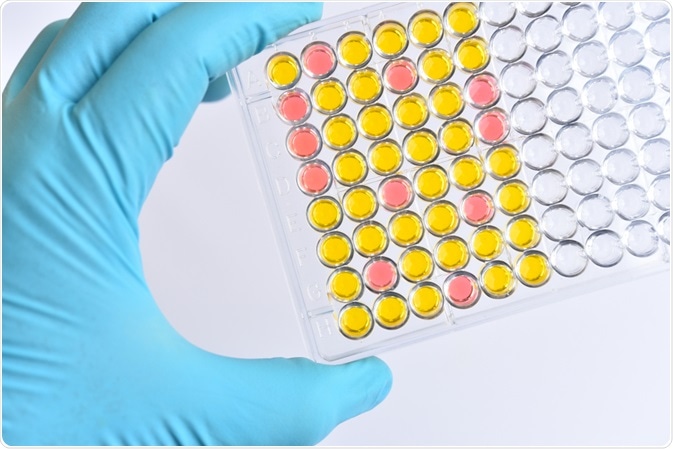The measurement of specific molecules in serum and plasma is essential in the diagnosis, treatment and management of many diseases. Traditional methods have used single assay techniques, whereby only one analyte of interest is measured per test. In contrast, multiplex microsphere assays (also referred to as bead assays) allow for the concise measurement of large numbers of analytes, saving time and expense whilst reducing error.
 An enzyme-linked immunosorbent assay (ELISA) plate. Image Credit: Jarun Ontakrai / Shutterstock.com
An enzyme-linked immunosorbent assay (ELISA) plate. Image Credit: Jarun Ontakrai / Shutterstock.com
Immunoassay
Multiplex microsphere assays are a form of immunological assay, which is a bioanalytical method of detecting, isolating or measuring a target biomolecule. The biomolecule of interest, which is referred to as an analyte, is quantified via the reaction of an antibody or antigen. An antigen is a molecular structure that induces an immune response: a pathogen such as a virus, whilst an antibody is a protein produced by the immune system in response to such a toxin.
Immunoassay methodology relies on a binding reaction between an analyte and an antibody. In immunology, this reaction is named the antigen-antibody interaction. As each antibody is only able to bind with a specific antigen, this specificity of reaction has useful clinical applications for the measurement of the analyte, particularly in diagnostic testing.
Although they share the same principle, different forms of immunoassay rely on different ways of signaling the degree of binding between the antigen and antibody. These include:
- Radioimmunoassay: The oldest form of immunoassay which is now rarely used due to the hazards associated with using radioactive substances. It involves attaching a radioactive isotope to the antigen of interest which is then bound with its complementary antibody. This is added to a sample that also contains the antigen to be measured, which competes with the radioactive antigen to replace it in the binding spot. The radioactivity of the final sample is measured, with the amount of radiation remaining being inversely related to the level of the antigen.
- Counting immunoassay: This approach uses polystyrene beads which are coated with the antibody specific to the antigen of interest. A sample containing the antigen is added and during incubation, a proportion of beads bind to the antigen to form a mass. The solution is passed through a cell counter, and the number of unbound beads is recorded. The greater the number of unbound beads, the lower the amount of antigen.
- Fluoro-immunoassay and chemiluminescent immunoassay: Both approaches share the same principle but use different methods of reporting antigen levels. In fluoro-immunoassay, the antibodies are labeled with fluorescent probes and after binding the strength of the fluorescence is measured. In chemiluminescent, the level of antigen is determined by measuring the intensity of luminosity occurring after a chemical reaction.
- Enzyme-linked immunosorbent assay (ELISA): The antigen of interest is combined with its complementary antibody, which has first been linked with an enzyme. After incubation, any unbound antibody is washed away, and a substrate is added to the solution. The enzyme that is linked to the antibody stimulates a chemical reaction in the substrate, producing a signal measurement (such as a color change) that allows the antigen to be quantified.
Multiplex microsphere assays
Multiplex assays are a type of immunoassay capable of simultaneous measurement of multiple analytes. Multiplex assays are derived from the ELISA format, but instead of producing a single signal measurement, they produce multiple signal measurements. In multiplex microsphere assays, microspheres in different colors are coated with different antibodies. After incubation, the results are read using flow cytometry which distinguishes the different colored beads by their varying levels of fluorescence.
Multiplex measurement offers two main advantages over single assay measurement:
- Measuring the properties of several analytes using single measurement assays such as ELISA requires multiple assays to be performed in parallel, which is expensive and time-consuming. However, parallel analyses also increase the risk of error when interpreting data collected at different time points and during different experiments.
- Multiplex measurement also allows the user to collect a large amount of data using smaller samples. In single parallel assays, a separate sample containing the analyte is used for each test. In multiplex assays, one single sample is used to measure multiple analytes.
- They allow us to see how different analytes interact with each other.
Applications of multiplex measurement
As multiplex assay techniques are highly sensitive, yet highly versatile, they are well suited to clinical applications such as immunology, cancer diagnosis and immuno-oncology. They are particularly useful for biomarker discovery where a panel of analytes are measured together as an indicator for a specific disease, a response to medical treatment, or for stratifying treatments at the patient level.
As they require samples in far smaller quantities than single assay testing, they are particularly valuable where sample volumes are limited. This includes research that uses mice models, research and clinical treatment of neonates and analysis of tumor biopsy samples.
Sources
- Abcam.com. (2019). A review of current multiplex immunoassay methods | Abcam.
- Elshal, M. and McCoy, J. (2006). Multiplex bead array assays: Performance evaluation and comparison of sensitivity to ELISA☆. Methods, 38(4), pp.317–323.
- Lluis M. Martínez, SEPMAG Chief Scientific Officer (2018). Different types of Immunoassays. [online] Sepmag.eu. Available at: https://www.sepmag.eu/blog/different-types-of-immunoassays.
- Szurdoki, F., Michael, K.L. and Walt, D.R. (2001). A Duplexed Microsphere-Based Fluorescent Immunoassay. Analytical Biochemistry, 291(2), pp.219–228.
Further Reading
Last Updated: Mar 14, 2023